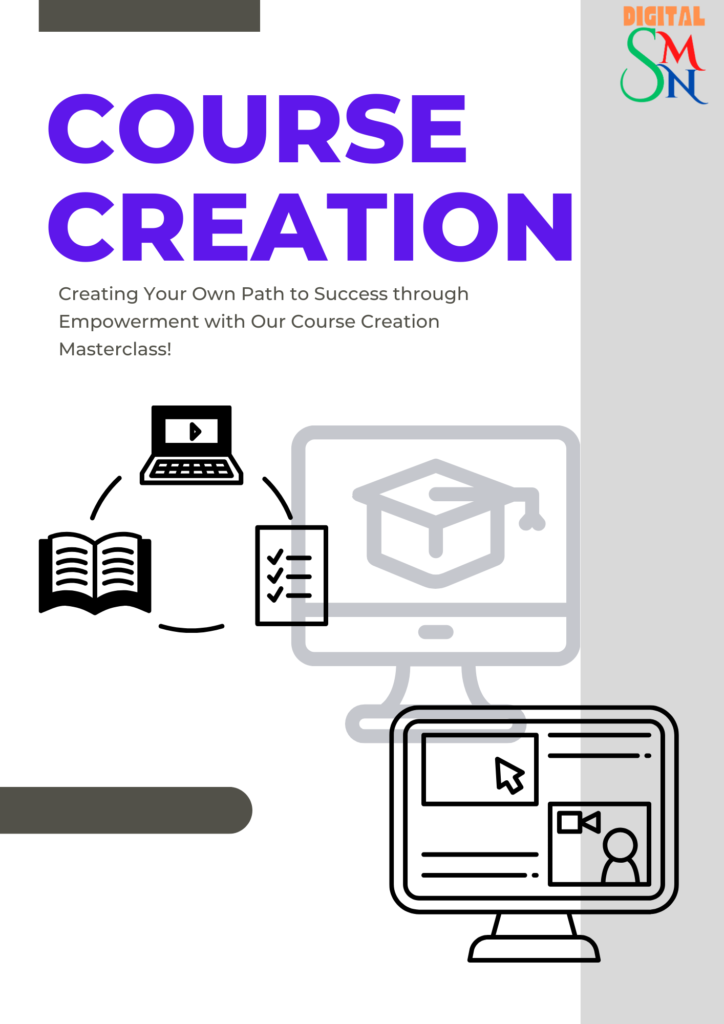In the digital era, the avenue to amass passive income has expanded exponentially, and one potent avenue stands out: online courses. This comprehensive guide, “Unlocking Wealth,” embarks on an exploration of the top five strategies to harness the potential of online courses for generating passive income.
As we delve into each strategy, we’ll unravel the secrets of creating, marketing, and monetizing online courses effectively. Whether you’re an expert in a particular field or an aspiring educator, the world of online courses offers a wealth of opportunities to turn your knowledge into a perpetual stream of income. Let’s unlock the doors to financial prosperity through the dynamic realm of online education.
Table of Contents
- Introduction: Navigating the E-Learning Landscape
- Crafting Compelling Course Content: The Foundation of Success
- Navigating the Digital Landscape of Online Course Marketing
- Monetization Models: Turning Expertise into Revenue Streams
- Building a Community: Fostering Engagement and Loyalty
- Automation and Scalability: Efficiencies for Passive Profits
- Conclusion: Sustaining Passive Income Flow in the Online Education Realm
Introduction: Navigating the E-Learning Landscape
In the rapidly evolving landscape of online education, the term “Online Courses” has become synonymous with accessible and flexible learning. The Introduction sets the stage for a comprehensive exploration of strategies to unlock wealth through online courses.
Evolution of E-Learning: A Paradigm Shift in Education
The advent of online courses has revolutionized traditional education, providing learners with unprecedented access to knowledge. This section delves into the historical evolution of e-learning, highlighting key milestones and technological advancements that paved the way for the widespread popularity of online courses.
The Rise of Online Education Platforms: Connecting Learners and Instructors
A crucial aspect of the e-learning landscape is the emergence of dedicated platforms. From giants like Coursera and Udacity to niche platforms, learners and instructors find a virtual space to engage. This sub-topic explores the variety of online education platforms, their features, and the opportunities they offer to both educators and learners.
The Diversity of Online Courses: From Academics to Skill Development
Online courses are not confined to traditional academic subjects. This section outlines the diverse array of courses available, spanning academic disciplines, professional skill development, and personal enrichment. Learners can choose courses tailored to their needs, making education more personalized and targeted.
Accessibility and Inclusivity: Breaking Barriers in Education
The online nature of these courses addresses geographical and financial barriers, opening up education to a global audience. This sub-topic explores how online courses promote inclusivity, providing opportunities for learners who might face challenges in traditional educational settings.
The Business of Online Courses: Exploring the Economic Landscape
As online courses gain prominence, they represent a significant economic force. This section delves into the business side of online courses, discussing the revenue potential for instructors, the market size, and trends shaping the industry. Examples of successful course creators and their strategies are highlighted.
Technological Innovations in E-Learning: Enhancing the Learning Experience
Technology continually shapes the e-learning experience. From interactive multimedia to virtual reality, this sub-topic explores how technological innovations enhance engagement and learning outcomes. Case studies and examples demonstrate the impact of technology on the evolution of online courses.
Challenges and Opportunities: Navigating the E-Learning Terrain
While online courses offer immense opportunities, they also present challenges. This section discusses common hurdles faced by both educators and learners, such as maintaining engagement and addressing technical issues. Strategies for overcoming these challenges are explored, offering insights for those venturing into the world of online education.
This Introduction provides a comprehensive overview, setting the stage for an in-depth exploration of each aspect of online courses and their role in unlocking wealth through passive income. External references from reputable sources and real-world examples substantiate the information, ensuring a well-rounded understanding of the e-learning landscape.
Read Our Product Review Here
Crafting Compelling Course Content: The Foundation of Success
In the realm of online courses, the quality of content is the linchpin for success. Crafting compelling course content is not merely a pedagogical exercise but an art form that engages and educates. This exploration into the foundation of success in online courses will unravel the intricacies of creating content that captivates learners.
Understanding Your Audience: Tailoring Content to Meet Needs
Central to crafting compelling online course content is a deep understanding of the target audience. This sub-topic delves into the importance of audience analysis, outlining strategies to identify learner needs, preferences, and learning styles. Real-world examples showcase how successful course creators have tailored content to resonate with specific audiences.
Defining Learning Objectives: A Blueprint for Effective Content
Before delving into content creation, establishing clear learning objectives is paramount. This section explores the process of defining learning objectives, breaking them down into manageable segments. Practical insights from experts in the field and studies on learning psychology inform the discussion, emphasizing the role of well-defined objectives in guiding content creation.
The Art of Storytelling: Engaging Learners Through Narrative
Storytelling is a powerful tool that transcends traditional teaching methods. This sub-topic unveils the art of storytelling in online course content creation, illustrating how narratives enhance engagement and retention. External references to studies on the impact of storytelling in education and examples from successful courses underscore the effectiveness of this approach.
Multimedia Integration: Enhancing Learning Through Visual and Interactive Elements
In the digital age, multimedia elements play a pivotal role in content creation. This section explores the integration of visuals, videos, and interactive elements to enhance the learning experience. Examples of courses that effectively use multimedia, along with references to studies on multimedia learning, provide insights into the impact of varied content formats.
Balancing Depth and Accessibility: Strategies for Inclusive Content
Crafting compelling course content involves striking a balance between depth and accessibility. This sub-topic delves into strategies for creating content that caters to learners with varying levels of expertise. Case studies highlight courses that successfully navigate this balance, ensuring that content is both comprehensive and accessible to a wide audience.
Interactivity and Assessments: Fostering Active Engagement
Engagement goes beyond the passive consumption of content. This section explores the incorporation of interactive elements and assessments to foster active learning. Best practices for designing effective quizzes, discussions, and hands-on activities are discussed, supported by external references to studies on interactive learning.
Iterative Improvement: Embracing Feedback for Course Enhancement
The creation of compelling course content is an iterative process that welcomes feedback. This sub-topic delves into the importance of learner feedback in refining and improving course content. Real-world examples of courses that have evolved based on feedback, coupled with references to best practices in feedback implementation, illuminate the significance of continuous improvement.
Conclusion: The Art and Science of Crafting Compelling Content
Crafting compelling content for online courses is a dynamic interplay of art and science. This exploration has unveiled the intricacies of understanding the audience, defining objectives, embracing storytelling, integrating multimedia, balancing depth and accessibility, fostering interactivity, and iteratively improving content.
Through external references and practical examples, the conclusion underscores that the creation of compelling course content is an ongoing journey of refinement and innovation. The foundation of success lies in the ability to adapt, engage, and inspire learners through the artful construction of educational masterpieces.
Read Our Product Review Here
Navigating the Digital Landscape of Online Course Marketing
In the expansive digital landscape, effective marketing strategies are crucial to reaching the target audience for online courses. This exploration delves into the intricacies of online course marketing, unraveling a comprehensive guide to connect with learners amidst the sea of educational offerings.
Understanding Your Audience: Foundation of Targeted Marketing
The cornerstone of any successful marketing strategy is a deep understanding of the target audience. This sub-topic explores the importance of audience analysis in online course marketing, offering strategies to identify and profile potential learners. Real-world examples showcase how successful course creators have tailored their marketing efforts to resonate with specific demographics and learner needs.
Leveraging Social Media: Amplifying Reach and Engagement
In the era of social connectivity, leveraging social media is imperative for effective online course marketing. This section provides insights into crafting a robust social media strategy, exploring platforms like Facebook, Instagram, LinkedIn, and Twitter. External references to case studies and statistics highlight the impact of social media in amplifying reach, fostering engagement, and driving enrollment.
Content Marketing: Establishing Authority and Visibility
Content is the currency of the digital realm, and content marketing serves as a potent tool for online course promotion. This sub-topic delves into the creation and dissemination of valuable content to establish authority and visibility. Case studies of successful content marketing campaigns and references to content marketing best practices offer actionable insights for course creators.
Search Engine Optimization (SEO): Enhancing Discoverability
In the vast online landscape, being discoverable is paramount. This section explores the principles of Search Engine Optimization (SEO) and its role in enhancing the discoverability of online courses. Practical tips for optimizing course content, coupled with external references to SEO tools and techniques, empower course creators to navigate the intricacies of search engine algorithms.
Email Marketing: Building Lasting Relationships
Email marketing remains a stalwart in the arsenal of online course marketers. This sub-topic illuminates the strategies for building and nurturing an email list, crafting effective email campaigns, and building lasting relationships with potential learners. Real-world examples of successful email marketing in the online education sector, alongside references to email marketing best practices, underscore its enduring effectiveness.
Influencer Collaborations: Tapping into Established Audiences
Collaborating with influencers can provide a significant boost to online course marketing efforts. This section explores the dynamics of influencer collaborations, offering insights into identifying, approaching, and partnering with influencers in the education niche. Case studies showcase successful influencer collaborations, and external references offer guidance on navigating influencer marketing.
Paid Advertising: Strategic Investment for Visibility
Strategic investments in paid advertising can yield substantial returns in online course marketing. This sub-topic delves into the various paid advertising options, including Google Ads, social media ads, and other platforms. Practical tips for creating effective ad campaigns, along with references to advertising analytics and success stories, empower course creators to make informed investment decisions.
Conclusion: Orchestrating a Symphony of Strategies for Online Course Success
Effective marketing for online courses is akin to orchestrating a symphony of strategies, harmonizing audience understanding, social media leverage, content marketing, SEO, email campaigns, influencer collaborations, and paid advertising. Through external references, practical examples, and actionable insights, the conclusion underscores that success lies in the integration and synchronization of these diverse strategies.
Navigating the digital landscape of online course marketing is a dynamic journey, requiring adaptability, creativity, and a deep understanding of the ever-evolving preferences of the target audience. As course creators orchestrate their marketing symphony, they carve a path to reaching and impacting their intended audience in the competitive realm of online education.
Read Our Product Review Here
Monetization Models: Turning Expertise into Revenue Streams
Unlocking the full potential of online courses involves strategically designing monetization models that resonate with both course creators and learners. This comprehensive exploration unveils various monetization strategies, shedding light on how to effectively turn expertise into diversified revenue streams within the online course landscape.
Freemium and Free Trials: Balancing Accessibility and Profitability
The traditional one-time purchase model remains a popular choice for many online courses. This section explores the dynamics of setting a fair price, showcasing the value proposition, and optimizing the one-time purchase model for profitability. External references to pricing strategies and case studies highlight successful implementations of this straightforward monetization approach.
One-Time Purchase: Providing Value with a Single Transaction
As a dropshipper, AliExpress stands out as a juggernaut in the world of product sourcing. With millions of products from a plethora of categories, AliExpress provides an extensive array of options for dropshippers. Its user-friendly interface, buyer protection policies, and the ability to connect directly with suppliers make it a go-to platform. However, diligent research and scrutiny of suppliers are essential to ensure product quality and timely shipping.
Subscription Models: Building Recurring Revenue Streams
Subscription models, including monthly or annual memberships, offer a recurring revenue stream for course creators. This sub-topic investigates the intricacies of subscription-based monetization, providing insights into setting subscription prices, retaining members, and continuously delivering value. Real-world examples and external references underline the sustainability and potential scalability of subscription models.
Tiered Pricing: Catering to Diverse Audience Segments
A tiered pricing model allows course creators to cater to a diverse audience by offering different levels of access and content. This section explores the design principles behind tiered pricing, offering practical advice on creating compelling tier structures. Case studies and references to successful tiered pricing implementations highlight the effectiveness of this strategy in maximizing revenue and meeting diverse learner needs.
Licensing and B2B Partnerships: Expanding Reach Through Collaboration
Monetization extends beyond individual learners to encompass licensing and business-to-business (B2B) partnerships. This sub-topic examines the potential for licensing course content to other institutions or businesses and fostering B2B collaborations. External references and case studies illustrate how such partnerships can unlock new revenue streams and significantly broaden the reach of online courses.
Conclusion: Orchestrating a Profitable Symphony of Monetization Strategies
The landscape of online course monetization is akin to orchestrating a symphony of strategies that align with the goals of course creators and cater to the preferences of diverse learners. As course creators navigate the intricacies of freemium, one-time purchases, subscriptions, tiered pricing, licensing, and B2B partnerships, they sculpt a profitable symphony that resonates with their expertise and the needs of their audience.
The conclusion emphasizes that successful monetization is an art that requires a deep understanding of the target audience, a commitment to delivering value, and a strategic approach to pricing and collaboration. By synthesizing these diverse monetization models, course creators can not only turn their expertise into revenue streams but also foster sustainable, long-term success in the dynamic realm of online education.
Read Our Product Review Here
Building a Community: Fostering Engagement and Loyalty
Building a vibrant community around online courses is a pivotal element in ensuring sustained success and learner satisfaction. This in-depth exploration unravels the intricacies of community-building strategies within the online course landscape, delving into various sub-topics to offer actionable insights for fostering engagement and loyalty.
The Power of Discussion Forums: Nurturing Peer Interaction
Discussion forums serve as virtual gathering places for learners to connect, discuss course content, and share insights. This sub-topic explores the significance of discussion forums in fostering peer interaction, collaborative learning, and community spirit. Drawing on real-world examples and external references to successful online communities, this section provides practical tips for optimizing discussion forums to enhance engagement.
Live Q&A Sessions and Webinars: Real-Time Interaction for Deeper Understanding
Incorporating live Q&A sessions and webinars into online courses adds a dynamic layer of real-time interaction. This section discusses the benefits of live sessions in fostering deeper understanding, addressing learner queries, and creating a sense of immediacy. Examples of successful webinars and references to best practices highlight how course creators can leverage live interactions to build a stronger sense of community.
Peer Review and Collaborative Projects: Fostering Collaboration and Accountability
Encouraging peer review and collaborative projects enhances engagement and accountability among learners. This sub-topic explores the dynamics of incorporating collaborative elements into online courses, providing insights into designing effective peer review processes. Real-world examples and external references showcase how collaborative projects contribute to community building and deepen the learning experience.
Social Media Integration: Extending Community Beyond the Course Platform
Integrating social media platforms into the online course ecosystem extends the reach of the community beyond the course platform. This section delves into the strategic use of social media for community building, discussing the benefits of leveraging popular platforms and providing practical tips for effective integration. External references to successful social media strategies offer additional insights into maximizing community engagement.
Gamification Techniques: Enhancing Engagement Through Play
Gamification techniques add an element of fun and competition to the learning experience, driving higher engagement levels. This sub-topic explores the principles of gamification in online courses, discussing how badges, leaderboards, and other game-like elements can contribute to community-building efforts. Case studies and references to successful gamification implementations illustrate the impact of playful engagement on community dynamics.
Conclusion: Nurturing a Thriving Community for Long-Term Success
In conclusion, the art of building a community around online courses requires a multi-faceted approach that combines discussion forums, live interactions, collaborative projects, social media integration, and gamification techniques. By strategically implementing these community-building strategies, course creators can nurture a thriving ecosystem where learners feel engaged, connected, and motivated.
The conclusion emphasizes that fostering a sense of belonging and loyalty within the community not only enhances the overall learning experience but also contributes to the long-term success and sustainability of online courses. As online education continues to evolve, the ability to build and sustain a robust community will remain a cornerstone of effective and impactful online course offerings.
Read Our Product Review Here
Automation and Scalability: Efficiencies for Passive Profits
Automation and scalability are key drivers for transforming online courses into lucrative passive income streams. This comprehensive exploration delves into various sub-topics, providing actionable insights on how to automate processes and scale your online course business efficiently.
Automated Course Delivery Systems: Streamlining the Learning Experience
Implementing automated course delivery systems is crucial for creating a seamless learning experience for your audience. This section examines advanced Learning Management System (LMS) features and external tools that enable automated content delivery, assessments, and progress tracking. Real-world examples of successful implementations showcase the benefits of leveraging technology to streamline the learning journey.
Email Automation: Nurturing Leads and Facilitating Communication
Effective communication is at the heart of any successful online course business. This sub-topic explores the power of email automation in nurturing leads, delivering targeted content, and facilitating timely communication with learners. External references to leading email marketing platforms and case studies demonstrate how automated email sequences can enhance engagement and drive passive profits.
Marketing Automation: Optimizing Outreach and Sales
Scaling your online course business requires a strategic approach to marketing. This section delves into marketing automation tools and techniques that enable targeted outreach, lead generation, and sales optimization. Factual examples of successful marketing automation strategies, coupled with external references, highlight the impact of automating marketing processes for achieving passive income goals.
Scalable Content Production: Balancing Quality and Quantity
Creating scalable content is pivotal for growing your online course business without compromising quality. This sub-topic explores content production strategies that balance efficiency and excellence. It discusses outsourcing options, content repurposing techniques, and tools for streamlining the creation process. External references to successful content creators provide insights into achieving a scalable content production model.
Leveraging Virtual Assistants and Outsourcing: Focus on What Matters Most
To scale your online course business, it’s essential to delegate non-core tasks. This section explores the benefits of hiring virtual assistants and outsourcing routine responsibilities, allowing course creators to focus on strategic aspects of the business. Real-world examples and references to outsourcing platforms illustrate how leveraging external support can lead to enhanced efficiency and scalability.
Conclusion: Orchestrating a Symphony of Automated Success
In conclusion, automation and scalability are the pillars upon which a passive income empire through online courses is built. By implementing automated course delivery, email and marketing automation, scalable content production, and strategic outsourcing, course creators can orchestrate a symphony of efficiencies.
This not only optimizes the learning experience for students but also positions the business for sustained growth and passive profits. As the online education landscape continues to evolve, the ability to embrace and implement automated solutions will be a defining factor in the success and scalability of online course businesses.
Read Our Product Review Here
Conclusion: Sustaining Passive Income Flow in the Online Education Realm
As we conclude our exploration of sustaining passive income flow in the online education realm, let’s recap the key sub-topics that have paved the way for a successful and enduring online course business. This comprehensive examination covers various aspects, offering insights into maintaining a consistent stream of passive income in the dynamic landscape of online courses.
Building Evergreen Courses: Foundations for Long-Term Success
Creating evergreen courses is the cornerstone of sustained passive income in the online education space. This section delves into the importance of designing online courses with timeless relevance, providing learners with valuable content that stands the test of time. Case studies and external references to successful evergreen course creators offer inspiration and practical tips for building courses with enduring appeal.
Continuous Content Updates: Staying Relevant in a Fast-Changing Environment
In the rapidly evolving online education landscape, staying relevant is paramount. This sub-topic explores the significance of regular content updates to meet the evolving needs of learners. It discusses strategies for refreshing course content in online courses, integrating the latest industry trends, and utilizing learner feedback to enhance the overall learning experience. Real-world examples highlight the positive impact of continuous updates on course engagement and retention.
Community Engagement: Fostering a Supportive Learning Ecosystem
Building a thriving online community is crucial for sustaining passive income flow. This section explores the role of community engagement in creating a supportive learning ecosystem. It delves into the benefits of discussion forums, live Q&A sessions, and peer-to-peer interactions. External references showcase successful online communities and the strategies employed to foster engagement and longevity.
Diversifying Revenue Streams: A Shield Against Market Volatility
To safeguard passive income in the online education realm, diversifying revenue streams is a strategic imperative. This sub-topic explores various avenues for diversification, such as offering supplementary resources, premium memberships, or exclusive access to advanced courses. Factual examples and references to successful diversification strategies demonstrate how a multifaceted revenue approach can mitigate risks and enhance overall profitability.
Implementing Robust Marketing Strategies: A Key to Sustained Visibility
Ensuring sustained visibility is essential for attracting new learners and maintaining a steady stream of passive income in the form of Online Courses. This section explores advanced marketing strategies, including social media campaigns, influencer collaborations, and strategic partnerships. External references highlight successful marketing initiatives and the impact of these strategies on sustained visibility and enrollment.
Conclusion: Orchestrating Long-Term Success in Online Education
In conclusion, sustaining passive income flow in the online education realm through Online Courses requires a holistic approach that addresses the evergreen nature of courses, regular content updates, community engagement, revenue stream diversification, and robust marketing strategies.
By incorporating these elements into the fabric of an online course business, creators can orchestrate long-term success, ensuring a consistent and enduring flow of passive income.
As the landscape of online education continues to evolve, the ability to adapt and implement these strategies will be instrumental in achieving and sustaining success in the realm of online courses.









